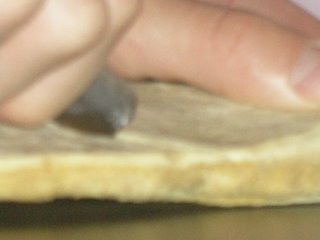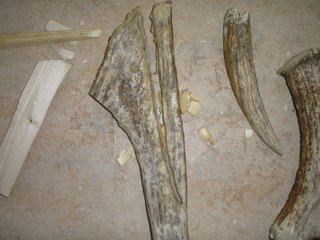NutritionThe body does, in addition to energy, require a lot of different other substances to function. Though this may initially seem like a deal breaker for living a life in the wild, it isn't. After all, that is what the body is designed for. If avoid the nutritional faults outlined here, chances are you will have an a lot healthier diet than most people today do.
Water
Though this isn't normally considered as nutrition, it is a major element of the body's composition and need to be given some attention as well. Drinking a lot of water is important to keep healthy. And that is equally true in winter, opposite common belief. How much you need to drink is variable to activity. Many say that drinking when you are thirsty too late and that your body is heavily dehydrated already. That may be so, but I trust that the body tells me when I need to drink more. To compensate , I drink a little more than I feel like when I drink.
If the water is likely to have a lot bacteria, which it rarely does in Norway, you should boil the water before drinking it. To this date, I have yet to boil water for drinking. Charcoal can supposedly filter out heavy metals and other dangerous substances, but do not take my word for it as I have never done it myself.
Vitamin C
To stay healthy, you need vitamin C. Lack of vitamin C, when well progressed, will ultimately result in scurvy. A condition causing loss of teeth and various other unfortunate consequences. Vitamin C is fortunately quite common in nature. It is found in many green plants, such as nettle and in great quantities in many berries, such as cloudberry. But what do you do in winter? Luckily, the organs of animals carry a lot of this vitamin. Not only mammals, but fish and fowl too. (Johansson 1991)
It is worth noticing that vitamin C is very intolerant of heat. That means that the food needs to be eaten raw, including meats and organs. Some people would rather drink pine needle tea, which also contains this vitamin. But if there are no pine, or you don't like pine tea (like me), then you don't have a choice in wintertime.
The trichina worm and other parasites
Getting parasites is a very serious matter. To a hunter-gatherer, life will often be sustained at the margins of energy surplus. A parasite will literally zap your energy and also deprive you of important trace elements. Tapeworms and other common internal parasites can be expelled by ingesting tansy (Chrysanthemum vulgare). Do however use this plant with caution, it is toxic to a degree. (Mabey 2001)
The trichina worm is a particularly dangerous parasite. It is harboured in muscular tissue of carnivores and omnivores. Of that reason: Never eat raw or poorly cooked meat of an animal that occasionally eats other animals. To be safe the meat needs to be heated to the temperature of 62C or until clear juices run from the meat. (Wikipedia)
Rodents (including hares) should not be consumed raw, because of the danger of tularaemia. If a hare looks ill, leave it alone. Better safe than sorry.
Salt and ionide
Two composites that are often of limited availability, especially in areas far from the sea, are salt and iodine. Plants contain little salt. Too little to sustain humans with enough without input of pure salt. If you have a high degree of vegetables in your diet you will need to have a way of getting salt. Salt is usually unevenly spread out. This is the reason why salt was a major trade commodity in southern areas already a long time ago. Herbivores accumulate salt through their diet. Consequently, by eating a lot of meat, you are probably getting enough salt. (Tulloch 2004)
There are many areas of this world with deficiency of iodine. Iodine is found in sea water, so the deficiencies are rarer there. How well this need is covered by eating meat I don't know, but I have heard nothing about inland Inuits and Siberian reindeer herders having goitre. A disease commonly caused by iodine deficiency. Icelandic lichens contains iodine, but in very small amounts according to unconfirmed rumours. In a primitive lifeway, especially if your diet is high in vegetables, it is probably wise to spend a longer period foraging and fishing by the sea.
Carbohydrates and fat
Except from the stomach contents of herbivores, there are little easily available carbohydrates in the northern areas. The further south you get, the more you have available to you. But no matter where you are in the temperate zone, there will not be much to find in winter. A consideration in this regard is protein poisoning, you need to eat quite a lot of either fat or carbohydrates or you will in essence starve. (Goring 2006, Kochanski 1988) The only solution left then, is fat. There is no point in even consuming lean animals as your energy level will still go down. Hares and other rodents are particularly lean as a rule. To avoid poisoning when subsisting primarily on these animals you need to boil the whole animal, intestines and all. (Kochanski 1988) Whether it is really necessary to throw away the skin, I am not sure of. I would assume though, that if you take off the skin but throw the little fat there is on the skin into the pot you would be fine.
Next Wednesday: Important food plants
Litterature:
Kochanski, M. (1988), Bushcraft: Outdoor Skills and Wilderness Survival. Edmonton, Lone Pine Publishing.
Johansson, T. (1994), Mat. Forntida Teknik. Issue 2, 2006, pp. 41-47.
Mabey, R. (2001), Food for Free. London, Collins.
Tulloch, A. (2004), Salt. Bulletin of Primitive Technology. Issue #28, Fall 2004.
Goring, S. (2006) The Reality of Food in the Bush (Part 2). Bushcraft. Issue 2, Summer 2006, pp. 18-21.
























